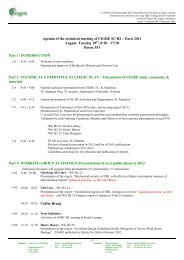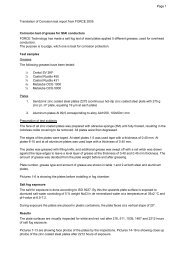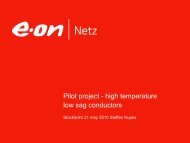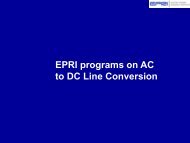Page 1 <strong>of</strong> 8IEEE PES Transactions on Power Systems> REPLACE THIS LINE WITH YOUR PAPER IDENTIFICATION NUMBER (DOUBLE-CLICK HERE TO EDIT) < 1123456789101112131415161718192021222324252627282930313233343536373839404142434445464748495051525354555657585960Abstract— This paper presents a new methodology <strong>for</strong>calculating the steady-state thermal rating <strong>of</strong> a given overheadline, which uses the wind speed data obtained from numericalanalysis <strong>of</strong> the atmospheric boundary layer - ABL. Themotivation behind this work is based on the difficulty and thehigh cost <strong>for</strong> monitoring the main weather parameters along theoverhead line, especially the variation <strong>of</strong> wind speed. In the newmethodology proposed in this paper, the spans with lower windspeed and lower clearance are defined as critical spans and,naturally, the thermal capacity <strong>of</strong> the overhead line is limited bythem. The results obtained in applying this methodology in a 138kV overhead line, with 133 spans, demonstrate the consistency <strong>of</strong>the proposed methodology and its applicability. There<strong>for</strong>e it willbe discussed how this new methodology can be applied both atdesign and at operation <strong>of</strong> overhead lines. In this case, theoperation team will improve security with possible maximization<strong>of</strong> electric energy transmission.Index Terms — <strong>Overhead</strong> <strong>Line</strong>, Weather Parameter, Steady-State Thermal Rating, <strong>Ampacity</strong>, Atmospheric Boundary Layer.AAmpABL - <strong>Methodology</strong> <strong>of</strong> <strong>Ampacity</strong><strong>Calculation</strong> <strong>for</strong> <strong>Overhead</strong> <strong>Line</strong> Considering theEffect <strong>of</strong> Atmospheric Boundary LayerI. INTRODUCTIONn important point in improving the process <strong>of</strong> calculatingsteady-state rating is the need to establish the mainweather parameters such as wind speed, temperature and solarradiation [1] throughout all spans <strong>of</strong> the overhead line. Themonitoring <strong>of</strong> weather conditions throughout the overhead lineby weather remote stations has a high cost [2], especially <strong>for</strong>long lines. Thus, a plausible starting point to work indetermining the wind speed, which is the parameter <strong>of</strong> majorweather influence in the calculation <strong>of</strong> thermal rating, is thenumerical study <strong>of</strong> atmospheric boundary layer - ABL [3], [4]around the overhead line.In order to validate the model <strong>of</strong> the ABL, it is necessary tohave the digital maps <strong>of</strong> topography and measurements <strong>of</strong>wind speed at some points on the boundary <strong>of</strong> the region andinside the ABL. Once the model is validated, the next step isto generate a database by simulations with different boundaryconditions and then to apply it in the determination <strong>of</strong> theworst weather spans, i.e. spans with the lowest values <strong>of</strong> windManuscript received May 25, 2009. This work was supported in part byCemig and Evolutionary Computation Laboratory from the ElectricalEngineering Department <strong>of</strong> UFMG.C. A. M. do Nascimento is with the Cemig in the EngineeringManagement <strong>of</strong> <strong>Overhead</strong> <strong>Line</strong>s (caxandre@cemig.com.br).J. A. Vasconcelos is with the Electrical Engineering Department fromUFMG and is the head <strong>of</strong> the Evolutionary Computation Laboratory(jvasconcelos@ufmg.br).C.A.M. do Nascimento and J.A. Vasconcelosspeed. It is important to mention that there is still nomethodology proposed in the literature <strong>for</strong> finding criticalspans in <strong>Overhead</strong> <strong>Line</strong>s [5]–[7].In this context, the main goal <strong>of</strong> this work is to present anew methodology <strong>for</strong> calculating the steady-state rating -AmpABL, which is more realistic than the traditional methods<strong>of</strong> calculation [7], [9]. In the presentation that follows, arebriefly presented the method <strong>for</strong> calculating the steady-statethermal rating, the proposed criterion <strong>for</strong> determining thecritical span, an introduction <strong>of</strong> the ABL model, a detaileddescription <strong>of</strong> the methodology AmpABL and finally itsapplication that was originally proposed in this work.II. STEADY-STATE THERMAL RATING CALCULATIONThe IEEE Std 738 -2006 defines the term “steady-statethermal rating” as "the constant electrical current that wouldyield the maximum allowable conductor temperature <strong>for</strong>specified weather conditions and conductor characteristicsunder the assumption that the conductor is in thermalequilibrium (steady state)". Considering only the mostsignificant terms in the thermal equilibrium as in (1),P + P = P + PJSRCit is possible to determine what is the maximum current thatcan flow in a conductor when considering the rate <strong>of</strong> loss byJoule effect. That is,2R (T )I P = P +CS RThen,I =C(1)+ P(2)PR+ PC− PSR(T )CThrough (1)-(3), P J , P S , P R and P C are respectively the rate<strong>of</strong> heat gain by Joule effect, the rate <strong>of</strong> heat gain by solarradiation, the rate <strong>of</strong> heat loss by radiation and the rate <strong>of</strong>convective heat loss (W/m). The parameters R and T C are theresistance per unit length (Ω/m) and the conductortemperature (°C).The steady-state thermal rating calculation <strong>of</strong> overhead lineis usually done <strong>for</strong> a maximum allowable conductortemperature specified in the design stage (T C < 100°C) andconservative weather conditions, that is, bounds <strong>of</strong> both windspeed <strong>of</strong> [0.6,1.2] (m/s) and summer temperature [30,45] (°C).(3)
IEEE PES Transactions on Power SystemsPage 2 <strong>of</strong> 8> REPLACE THIS LINE WITH YOUR PAPER IDENTIFICATION NUMBER (DOUBLE-CLICK HERE TO EDIT) < 2123456789101112131415161718192021222324252627282930313233343536373839404142434445464748495051525354555657585960III. STEADY-STATE CONDUCTOR TEMPERATURECALCULATIONThe rates <strong>of</strong> heat loss by convection and radiation are notlinearly dependent on the temperature <strong>of</strong> the conductor, thusthe equation <strong>of</strong> thermal balance (1) can be solved to determinethe temperature <strong>of</strong> the conductor in terms <strong>of</strong> the current andthe weather variables through an iterative process [10], i.e.according to the following steps:a) Take an initial conductor temperature T R , the current I C <strong>for</strong>which the conductor temperature is expected and a smalltolerance number ε.b) Calculate the corresponding heat losses P R and P C , the heatgain by solar radiation P S and the conductor resistanceR(T R ).c) Calculate the conductor current (I R ) <strong>for</strong> the referencetemperature (T R ) using (3).d) Compare the values <strong>of</strong> I C and I R .• If |I C -I R | ≤ ε, stop the iteration and consider the T R valueas the solution, i.e., T C = T R .• If |I C -I R | > ε, increase T R , otherwise T R is decreased.e) Return to step “b”.IV. CRITERIA FOR DETERMINING CRITICAL SPANSThe determination <strong>of</strong> critical spans is an important taskbecause if an electrical failure occurs, the major probability isthat it will take place in one <strong>of</strong> these spans. The definitions <strong>of</strong>critical spans, with the factors that influence them, are in arefined manner discussed in [2]. The critical spans arebasically those with slowest values <strong>of</strong> wind speed andconcurrently lowest clearance between conductor and nearestgrounded object.In the proposed AmpABL methodology, the determination<strong>of</strong> critical spans is carried out in an original and low cost wayif compared to the cost <strong>of</strong> instrumenting every span, which isnecessary <strong>for</strong> monitoring the whole transmission line, asmentioned in [2]. Basically, the difference is that the values <strong>of</strong>wind speed considered in the proposed methodology isobtained from simulations <strong>of</strong> atmospheric boundary layer,with prescribed boundary conditions (wind speed = 1 m/s atdifferent directions <strong>of</strong> incidence). The spans that havenumerical results <strong>of</strong> wind speed less than 1 m/s are consideredworst weather spans. The reference value <strong>of</strong> 1m/s <strong>for</strong> the windspeed at the boundary surfaces is a technical criterion based onthe region <strong>of</strong> the world considered. Of course, this valueshould be different <strong>for</strong> other region in the world.Mathematically, let S we be the set <strong>of</strong> critical spans withrespect to electrical clearance [11], i.e., the set composed byspans with clearance less than a certain clearance value <strong>of</strong>reference, which is dependent <strong>of</strong> the transmission line design.Let S ww be the set <strong>of</strong> worst weather spans, i.e., the setcomposed by spans with numerical results <strong>of</strong> wind speednormal to the axis <strong>of</strong> the conductor lower than the referencevalue <strong>of</strong> 1 m/s.Note that a span belonging to S we has a higher probability<strong>of</strong> violating the minimum safety clearance compared toanother not belonging to S we . There<strong>for</strong>e, one span <strong>of</strong> S we willhave a greater probability <strong>of</strong> electrical failure. Furthermore,the spans that belong to S ww have less cooling capacity <strong>of</strong> theconductor and there<strong>for</strong>e greater thermal risk.Now, let S ∩be the set <strong>of</strong> spans obtained by thewintersection <strong>of</strong> S ww and S we as in (4).S= S∩ Sew∩ e ww we(4)Eliminating from theS ∩the dominated spans bywapplying a non-dominance criterion, the result is a set <strong>of</strong> nondominated1 spans with small clearance and wind speed. Letthis set <strong>of</strong> non-dominated spans be S c .Note that the spans belonging to S c <strong>for</strong>m a non-dominatedfrontier in the space “wind speed versus clearance”. They arethose with simultaneously smallest clearances and lowest windspeeds, among all spans <strong>of</strong> the overhead line. That is, they arestrong candidates to be the critical critical spans in terms <strong>of</strong>risk <strong>of</strong> failure and thermal risk. Once determined the set S c , itis necessary to determine the critical spans, by calculating theconductor temperature <strong>of</strong> each span and their newcorresponding clearance. The critical span is the one thatwould always be hottest and/or nearest to clearance limits <strong>for</strong>a given current loading.V. ATMOSPHERIC BOUNDARY LAYER - ABLThe region <strong>of</strong> ABL is defined as a thin layer <strong>of</strong> theatmosphere, adjacent to the surface (up to 2 km in height),where wind speed show a high Reynolds number. This flow <strong>of</strong>wind occurs at different scales, each scale is described interms <strong>of</strong> computational domain with a different model. Thesemodels use the same governing equations [3], showingdifferences only in terms <strong>of</strong> simplifications <strong>of</strong> source, whichdepends mainly on the computational domain and the thermalstratification. The equations governing these flows are thegeophysical equations <strong>of</strong> continuity, conservation <strong>of</strong>momentum, conservation <strong>of</strong> energy and conservation <strong>of</strong>chemical species. The wind speed simulation models areclassified into four categories: global circulation, weather<strong>for</strong>ecast, meso-scale and micro-scale. The global circulationmodel is used in domains between 200 and 500 km along theearth’s surface and is used to analyse the vector <strong>of</strong> wind speed.The models <strong>for</strong> weather <strong>for</strong>ecast are used <strong>for</strong> domains between50 and 100 km to solve problems <strong>of</strong> weather fronts. The mesoscalemodels are used typically <strong>for</strong> domains from 2 to 50 kmand employed in the wind speed studies influenced by thetopography, and finally the micro-scale models are used <strong>for</strong>small specific domains and employed in studies where thewind is influenced by the regionalization <strong>of</strong> the earth's surface.The numerical study <strong>of</strong> the ABL in complex topography <strong>for</strong>use in climatological studies was introduced in [4]. The details<strong>of</strong> modelling the boundary layer are presented in Appendix A.e1 One vector u = (u 1, . . . , u k) dominate another vector v = (v 1, . . . , v k)(represented by u v) if and only if u is partially less than v. i.e.,∀ i ∈{1,...,k },ui ≤ vi and ∃ i ∈{1,...,k }| ui < vi} . If the vector u isnot-dominated by any other vector in the space, the vector u is a nondominatedvector.






